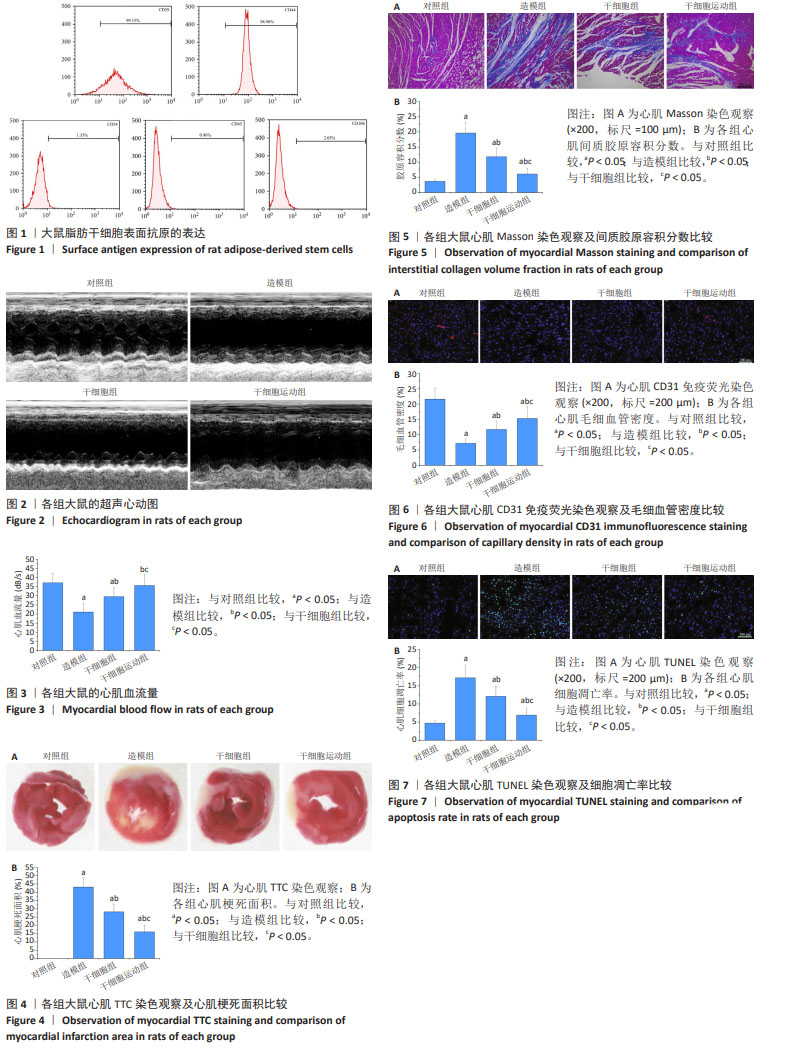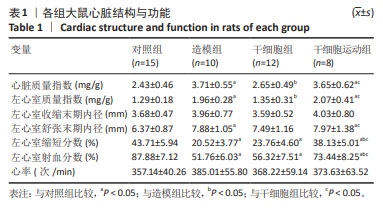[1] DAUERMAN HL, IBANEZ B. The edge of time in acute myocardial infarction. J Am Coll Cardiol. 2021;77(15):1871-1874.
[2] SAITO Y, OYAMA K, TSUJITA K, et al. Treatment strategies of acute myocardial infarction: updates on revascularization, pharmacological therapy, and beyond. J Cardiol. 2023;81(2):168-178.
[3] FRANTZ S, HUNDERTMARK MJ, SCHULZ-MENGER J, et al. Left ventricular remodelling post-myocardial infarction: pathophysiology, imaging, and novel therapies. Eur Heart J. 2022;43(27):2549-2561.
[4] WANG L, MA Y, JIN W, et al. Coronary microcirculation dysfunction evaluated by myocardial contrast echocardiography predicts poor prognosis in patients with ST-segment elevation myocardial infarction after percutaneous coronary intervention. BMC Cardiovasc Disord. 2022;22(1):e572.
[5] CABLE J, FUCHS E, WEISSMAN I, et al. Adult stem cells and regenerative medicine-a symposium report. Ann N Y Acad Sci. 2020;1462(1):27-36.
[6] DENG S, ZHOU X, GE Z, et al. Exosomes from adipose-derived mesenchymal stem cells ameliorate cardiac damage after myocardial infarction by activating S1P/SK1/S1PR1 signaling and promoting macrophage M2 polarization. Int J Biochem Cell Biol. 2019;114:105-114.
[7] YANG K, SONG HF, HE S, et al. Effect of neuron-derived neurotrophic factor on rejuvenation of human adipose-derived stem cells for cardiac repair after myocardial infarction. J Cell Mol Med. 2019;23(9):5981-5993.
[8] AL-GHADBAN S, BUNNELL BA. Adipose tissue-derived stem cells: immunomodulatory effects and therapeutic potential. Physiology (Bethesda). 2020;35(2):125-133.
[9] PARIZADEH SM, JAFARZADEH-ESFEHANI R, GHANDEHARI M, et al. Stem cell therapy: a novel approach for myocardial infarction. J Cell Physiol. 2019;234(10):16904-16912.
[10] 孙维兴,赵永超,赵然尊.间充质干细胞移植治疗心肌梗死:问题、症结及新突破[J].中国组织工程研究,2021,25(19): 3103-3109.
[11] 姜俣,钱海燕.间充质干细胞治疗心肌梗死的研究进展[J].基础医学与临床, 2023,43(1):21-29.
[12] 黄宏,邱伟,陈民佳,等.干细胞预处理及其保护机制的研究进展[J].中华损伤与修复杂志(电子版),2017,12(2):138-142.
[13] DROWLEY L, OKADA M, BECKMAN S, et al. Cellular antioxidant levels influence muscle stem cell therapy. Mol Ther. 2010;18(10):1865-1873.
[14] YOKOYAMA R, II M, MASUDA M, et al. Cardiac regeneration by statin-polymer nanoparticle-loaded adipose-derived stem cell therapy in myocardial infarction. Stem Cells Transl Med. 2019;8(10):1055-1067.
[15] QIN Y, KUMAR BUNDHUN P, YUAN ZL, et al. The effect of high-intensity interval training on exercise capacity in post-myocardial infarction patients: a systematic review and meta-analysis. Eur J Prev Cardiol. 2022;29(3):475-484.
[16] COLLET BC, DAVIS DR. Mechanisms of cardiac repair in cell therapy. Heart Lung Circ. 2023;32(7):825-835.
[17] 张敏,娄国,付常喜.有氧运动预适应改善骨髓间充质干细胞治疗急性心肌梗死的效果[J].中国组织工程研究,2024,28(25):3988-3993.
[18] GUO Y, LI Q, XUAN YT, et al. Exercise-induced late preconditioning in mice is triggered by eNOS-dependent generation of nitric oxide and activation of PKCε and is mediated by increased iNOS activity. Int J Cardiol. 2021;340:68-78.
[19] LIAO Z, LI D, CHEN Y, et al. Early moderate exercise benefits myocardial infarction healing via improvement of inflammation and ventricular remodelling in rats. J Cell Mol Med. 2019;23(12):8328-8342.
[20] MOAZZAMI K, LIMA BB, HAMMADAH M, et al. Association between change in circulating progenitor cells during exercise stress and risk of adverse cardiovascular events in patients with coronary artery disease. JAMA Cardiol. 2020;5(2):147-155.
[21] COSMO S, FRANCISCO JC, CUNHA RC, et al. Effect of exercise associated with stem cell transplantation on ventricular function in rats after acute myocardial infarction. Rev Bras Cir Cardiovasc. 2012;27(4):542-551.
[22] CHIRICO EN, DING D, MUTHUKUMARAN G, et al. Acute aerobic exercise increases exogenously infused bone marrow cell retention in the heart. Physiol Rep. 2015;3(10): e12566.
[23] QUINDRY JC, FRANKLIN BA. Exercise preconditioning as a cardioprotective phenotype. Am J Cardiol. 2021;148:8-15.
[24] 陈天然,潘珊珊.运动预适应:心脏康复预防与治疗的新策略[J].上海体育学院学报,2021,45(10):72-80.
[25] NAKAMUTA JS, DANOVIZ ME, MARQUES FL, et al. Cell therapy attenuates cardiac dysfunction post myocardial infarction: effect of timing, routes of injection and a fibrin scaffold. PLoS One. 2009;4(6):e6005.
[26] DOS SANTOS L, SANTOS AA, GONÇALVES GA, et al. Bone marrow cell therapy prevents infarct expansion and improves border zone remodeling after coronary occlusion in rats. Int J Cardiol. 2010;145(1):34-39.
[27] 娄国,张艳,付常喜.内皮型一氧化氮合酶在运动预适应改善心肌缺血-再灌注损伤中的作用[J].中国组织工程研究,2024,28(8):1283-1288.
[28] JI Z, WANG C, TONG Q. Role of miRNA-324-5p-modified adipose-derived stem cells in post-myocardial infarction repair. Int J Stem Cells. 2021;14(3): 298-309.
[29] AN J, DU Y, LI X, et al. Myocardial protective effect of sacubitril-valsartan on rats with acute myocardial infarction. Perfusion. 2022;37(2):208-215.
[30] SU HL, QIAN YQ, WEI ZR, et al. Real-time myocardial contrast echocardiography in rat: infusion versus bolus administration. Ultrasound Med Biol. 2009;35(5):748-755.
[31] WU X, REBOLL MR, KORF-KLINGEBIEL M, et al. Angiogenesis after acute myocardial infarction. Cardiovasc Res. 2021;117(5):1257-1273.
[32] LI J, ZHAO Y, ZHU W. Targeting angiogenesis in myocardial infarction: Novel therapeutics (Review). Exp Ther Med. 2022;23(1):e64.
[33] LALU MM, MAZZARELLO S, ZLEPNIG J, et al. Safety and efficacy of adult stem cell therapy for acute myocardial infarction and ischemic heart failure (safecell heart): A systematic review and meta-analysis. Stem Cells Transl Med. 2018;7(12):857-866.
[34] CLAVELLINA D, BALKAN W, HARE JM. Stem cell therapy for acute myocardial infarction: Mesenchymal stem cells and induced pluripotent stem cells. Expert Opin Biol Ther. 2023;23(10):951-967.
[35] SHINMURA D, TOGASHI I, MIYOSHI S, et al. Pretreatment of human mesenchymal stem cells with pioglitazone improved efficiency of cardiomyogenic transdifferentiation and cardiac function. Stem Cells. 2011;29(2):357-366.
[36] KHAN M, MEDURU S, MOHAN IK, et al. Hyperbaric oxygenation enhances transplanted cell graft and functional recovery in the infarct heart. J Mol Cell Cardiol. 2009;47(2):275-287.
[37] TANG JM, WANG JN, ZHANG L, et al. VEGF/SDF-1 promotes cardiac stem cell mobilization and myocardial repair in the infarcted heart. Cardiovasc Res. 2011;91(3):402-411.
[38] RETUERTO MA, BECKMANN JT, CARBRAY J, et al. Angiogenic pretreatment to enhance myocardial function after cellular cardiomyoplasty with skeletal myoblasts. J Thorac Cardiovasc Surg. 2007;133(2):478-484.
[39] ALBAENI A, DAVIS JW, AHMAD M. Echocardiographic evaluation of the Athlete’s heart. Echocardiography. 2021;38(6):1002-1016.
[40] 朱政,付常喜,马文超,等.有氧运动调控自发性高血压模型大鼠心脏重塑的机制[J].中国组织工程研究,2022,26(14):2231-2237.
[41] GHAFOURI-FARD S, KHANBABAPOUR SASI A, HUSSEN BM, et al. Interplay between PI3K/AKT pathway and heart disorders. Mol Biol Rep. 2022;49(10):9767-9781.
[42] XIANG FL, LU X, LIU Y, et al. Cardiomyocyte-specific overexpression of human stem cell factor protects against myocardial ischemia and reperfusion injury. Int J Cardiol. 2013;168(4):3486-3494.
[43] BRAILE M, MARCELLA S, CRISTINZIANO L, et al. VEGF-A in cardiomyocytes and heart diseases. Int J Mol Sci. 2020;21(15):e5294.
[44] ZHOU C, KUANG Y, LI Q, et al. Endothelial S1pr2 regulates post-ischemic angiogenesis via Akt/eNOS signaling pathway. Theranostics. 2022;12(11):5172-5188.
[45] WANG N, ZHANG C, XU Y, et al. Berberine improves insulin-induced diabetic retinopathy through exclusively suppressing Akt/mTOR-mediated HIF-1α/VEGF activation in retina endothelial cells. Int J Biol Sci. 2021;17(15):4316-4326.
[46] AZIZ NS, YUSOP N, AHMAD A. Importance of stem cell migration and angiogenesis study for regenerative cell-based therapy: A review. Curr Stem Cell Res Ther. 2020;15(3):284-299.
[47] ZHAO T, ZHAO W, CHEN Y, et al. Differential expression of vascular endothelial growth factor isoforms and receptor subtypes in the infarcted heart. Int J Cardiol. 2013;167(6):2638-2645.
[48] WANG HJ, RAN HF, YIN Y, et al. Catalpol improves impaired neurovascular unit in ischemic stroke rats via enhancing VEGF-PI3K/Akt and VEGF-MEK1/2/ERK1/2 signaling. Acta Pharmacol Sin. 2022;43(7):1670-1685.
[49] SHIBUYA M. VEGF-VEGFR system as a target for suppressing inflammation and other diseases. Endocr Metab Immune Disord Drug Targets. 2015;15(2):135-144.
[50] XU X, YE X, ZHU M, et al. FtMt reduces oxidative stress-induced trophoblast cell dysfunction via the HIF-1α/VEGF signaling pathway. BMC Pregnancy Childbirth. 2023;23(1):e131.
|


